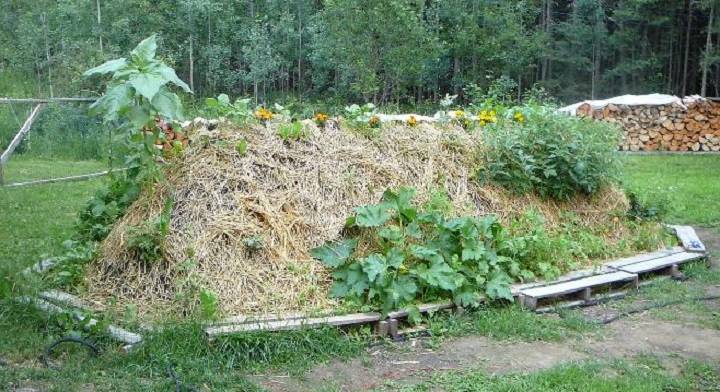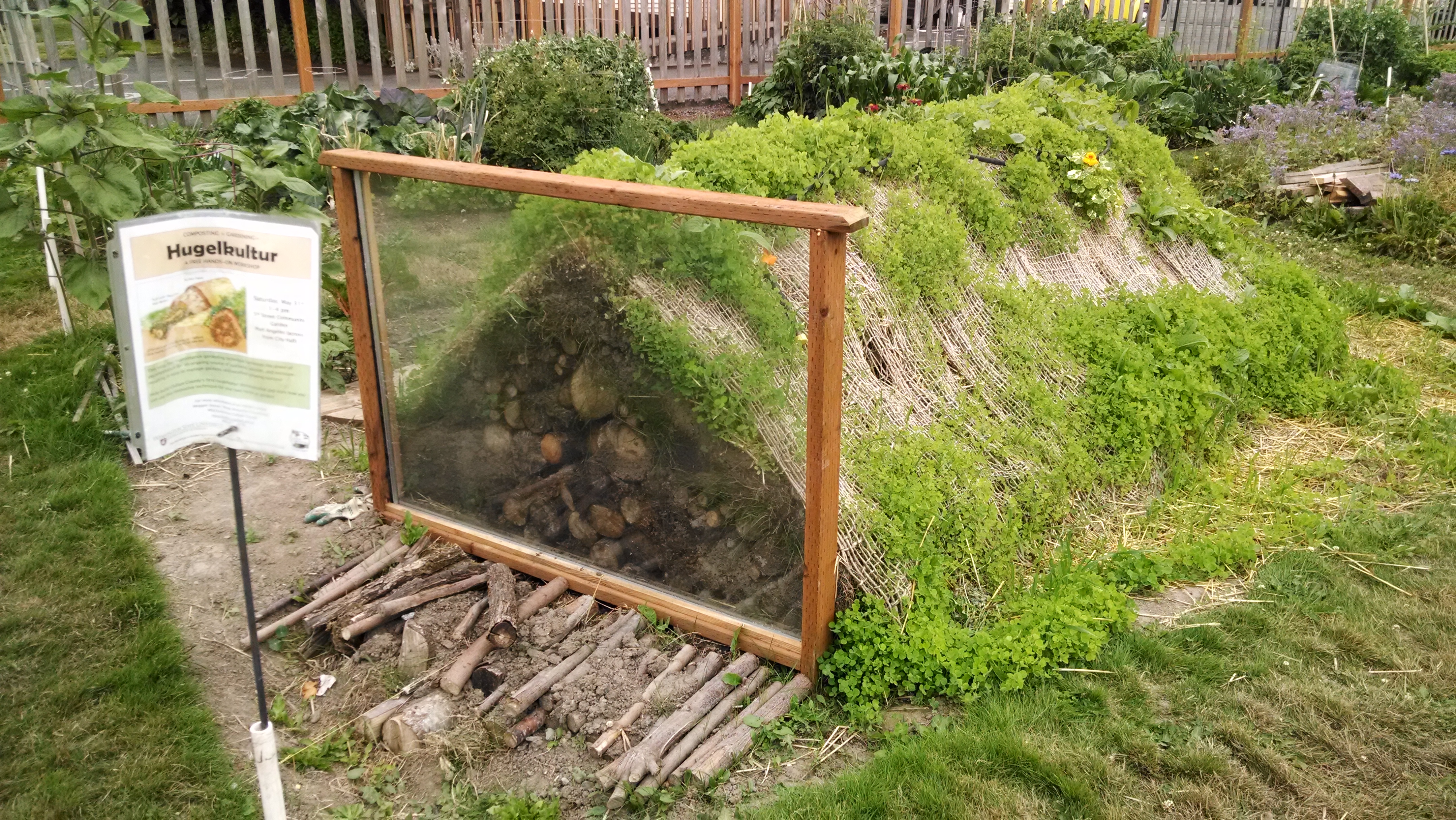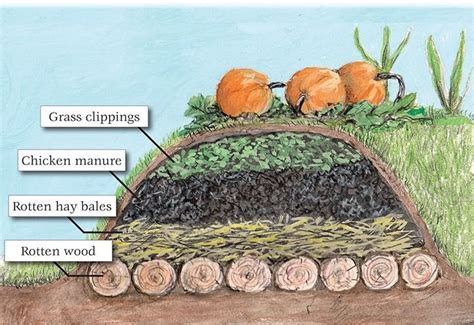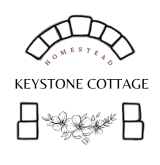Permaculture is a way of gardening that is all about sustainability and working in harmony with the natural world. It’s a way of growing your own food using organic methods and natural resources.
One of the amazing techniques used in permaculture is hugelkultur beds, which are essentially raised garden beds that are made from a combination of organic matter, compost, and soil. Hugelkultur beds are a fantastic option for anyone who is interested in permaculture because they are completely self-sustaining, meaning that they don’t require any additional inputs (like chemical fertilizers) in order to thrive.
They are extremely versatile and can be used in small gardens or big agricultural operations, and they are especially good at conserving water and providing a fertile environment for plants to grow in.
In this post, we will dive deep into the world of hugelkultur beds in permaculture, exploring what they are, why they are so beneficial, and exactly how you can build one step-by-step!

The Essence of Hugelkultur
Hugelkultur, the revolutionary technique for growing plants, is gaining enormous popularity among gardeners these day as an all-natural and sustainable way to build your garden.
Essentially, it involves making raised garden beds by layering organic materials, such as logs, branches, leaves and compost, into a mound shape. The idea is that the mound will decompose over time, enriching the soil and creating the perfect growing environment for plants. This type of gardening has several benefits, including better water retention, nutrient-rich soil, and less maintenance.
With hugelkultur, you can create the perfect garden bed easily without worrying about watering and fertilizing. So, if you are passionate about gardening, it’s time to try hugelkultur and watch your garden thrive season after season.
History
Hugelkultur beds, a time-tested technique embraced by modern permaculture enthusiasts, have a rich history rooted in traditional European agricultural practices. Originating in Germany and Eastern Europe, the term “Hugelkultur” translates to “hill culture” or “mound culture” in German. This ancient method of gardening dates back centuries, with its origins obscured by the passage of time.
Early practitioners observed nature’s decomposition processes, noting how fallen trees and organic matter created fertile mounds in forests. They then emulated these natural systems by stacking logs, branches, and organic materials to create raised garden beds. By doing so, they harnessed the benefits of improved soil fertility, enhanced water retention, and reduced maintenance, all of which are hallmarks of Hugelkultur beds.
Over the years, this sustainable gardening technique has evolved and gained popularity worldwide, with modern homesteaders and permaculturists rediscovering and refining the art of Hugelkultur for more sustainable and productive gardens.
Benefits of Hugelkultur Beds
Hugelkultur beds offer a range of benefits, making them an excellent addition to any homestead or permaculture garden:
Improved Soil Fertility: As the organic materials decompose, they release valuable nutrients into the soil, creating a nutrient-rich environment that promotes healthy plant growth.
Water Retention: Hugelkultur beds act like sponges, retaining moisture in the soil for extended periods. This reduces the need for frequent watering, making them drought-resistant.
Reduced Weeding: The raised bed structure and decomposition process discourage weed growth, minimizing the time and effort required for weeding.
Extended Growing Season: The increased thermal mass of Hugelkultur beds allows for earlier planting in the spring and longer growing seasons into the fall.
Minimal Maintenance: Once established, Hugelkultur beds require minimal maintenance compared to traditional garden beds. The decomposition process sustains the bed, reducing the need for fertilizers and pesticides.
Building Your Hugelkultur Bed

Creating a Hugelkultur bed is a straightforward process that can be adapted to suit the space and resources available on your homestead. Here’s a step-by-step guide to get you started:
Choose a Location: Select a sunny or partially shaded spot for your Hugelkultur bed. Ensure it is accessible for planting, watering, and harvesting.
Gather Materials: The foundation of your Hugelkultur bed will consist of large logs or branches. Collect dead wood from fallen trees, pruned branches, or other available sources. Smaller branches, leaves, straw, and grass clippings will be used to fill in the layers.
Dig a Trench: Dig a trench about one to two feet deep and as wide as you desire your bed to be. The length of the trench is up to you, but a minimum of four feet is recommended for effective decomposition.
Place Logs and Branches: Lay the larger logs and branches in the trench, filling it to the top. Compact them down as you go to create a stable base.
Layer Organic Material: On top of the logs, start adding layers of smaller branches, leaves, straw, and other organic matter. Aim for a height of about two feet above the ground level.
Add Compost and Topsoil: Cover the organic layers with a generous amount of compost and topsoil. This is where you’ll plant your vegetables and herbs.
Plant Your Garden: Once your Hugelkultur bed is built and filled, you can plant your choice of crops directly into the soil on top.

What to grow
Hugelkultur beds are known for their ability to create nutrient-rich and moisture-retentive growing environments, which make them suitable for a wide variety of plants. Here’s a list of some of the best plants to grow in Hugelkultur beds:
Perennials: Hugelkultur beds are excellent for perennial plants such as fruit trees (apple, pear, cherry), berry bushes (blueberries, raspberries, blackberries), and perennial herbs (rosemary, thyme, oregano). The consistent moisture and rich soil support their long-term growth.
Vegetables: Most vegetables thrive in Hugelkultur beds. Consider planting tomatoes, peppers, squash, cucumbers, and zucchini, as they benefit from the moisture retention and nutrient-rich soil.
Herbs: Herbs like basil, parsley, cilantro, and mint flourish in Hugelkultur beds. The consistent moisture and nutrient supply contribute to their aromatic and flavorful growth.
Root Crops: Root vegetables such as carrots, potatoes, beets, and radishes can be successfully grown in Hugelkultur beds, benefiting from the loose, well-aerated soil.
Leafy Greens: Leafy greens like lettuce, kale, spinach, and Swiss chard appreciate the moisture-conserving properties of Hugelkultur beds, resulting in tender and abundant leaves.
Flowers: Many ornamental flowers, including sunflowers, marigolds, and dahlias, thrive in Hugelkultur beds. The improved soil quality and moisture levels can lead to more vibrant blooms.
Native Plants: Consider planting native plants that are adapted to your region’s climate. These plants often require less maintenance and can attract local wildlife to your garden.
Companion Plants: Utilize companion planting principles by growing plants that benefit each other. For example, pairing beans with corn and squash (the “Three Sisters” technique) can work well in Hugelkultur beds, as they support each other’s growth.
Vining Plants: Climbing plants like beans, peas, and certain varieties of cucumbers and melons can thrive in Hugelkultur beds. The raised nature of the beds makes it easier for their vines to grow and spread.
Medicinal Plants: If you’re interested in herbal medicine, consider growing medicinal plants like echinacea, lavender, or calendula in your Hugelkultur bed. The rich soil can enhance their therapeutic properties.
While Hugelkultur beds are versatile and can accommodate a wide range of plants, it’s essential to consider your local climate and soil conditions when selecting what to grow. Experimenting with different plant combinations can help you discover what thrives best in your specific Hugelkultur setup, leading to a productive and diverse garden.
Conclusion,
Hugelkultur beds exemplify the principles of permaculture by utilizing natural processes to create a self-sustaining and productive garden. Whether you’re a seasoned homesteader or a novice gardener, implementing Hugelkultur in your permaculture design can yield bountiful harvests while reducing your environmental footprint. So, roll up your sleeves, gather those fallen branches, and embark on your journey to sustainable gardening with Hugelkultur beds. Your homestead will thank you, and so will the planet.
